You need to recommend a solution to generate a monthly report of all the new Azure Resource Manager (ARM) resource deployments in your Azure subscription.
What should you include in the recommendation?
Answer:
D
DRAG DROP
-
You have an Azure AD tenant that contains an administrative unit named MarketingAU. MarketingAU contains 100 users.
You create two users named User1 and User2.
You need to ensure that the users can perform the following actions in MarketingAU:
• User1 must be able to create user accounts.
• User2 must be able to reset user passwords.
Which role should you assign to each user? To answer, drag the appropriate roles to the correct users. Each role may be used once, more than once, or not at all. You may need to drag the split bar between panes or scroll to view content.
NOTE: Each correct selection is worth one point.
Answer:

You need to recommend a solution to generate a monthly report of all the new Azure Resource Manager (ARM) resource deployments in your Azure subscription.
What should you include in the recommendation?
Answer:
B
You have 100 servers that run Windows Server 2012 R2 and host Microsoft SQL Server 2014 instances. The instances host databases that have the following characteristics:
✑ Stored procedures are implemented by using CLR.
✑ The largest database is currently 3 TB. None of the databases will ever exceed 4 TB.
You plan to move all the data from SQL Server to Azure.
You need to recommend a service to host the databases. The solution must meet the following requirements:
✑ Whenever possible, minimize management overhead for the migrated databases.
✑ Ensure that users can authenticate by using Azure Active Directory (Azure AD) credentials.
✑ Minimize the number of database changes required to facilitate the migration.
What should you include in the recommendation?
Answer:
B
SQL Managed Instance allows existing SQL Server customers to lift and shift their on-premises applications to the cloud with minimal application and database changes. At the same time, SQL Managed Instance preserves all PaaS capabilities (automatic patching and version updates, automated backups, high availability) that drastically reduce management overhead and TCO.
Reference:
https://docs.microsoft.com/en-us/azure/sql-database/sql-database-managed-instance
You have an Azure subscription that contains an Azure Blob Storage account named store1.
You have an on-premises file server named Server1 that runs Windows Server 2016. Server1 stores 500 GB of company files.
You need to store a copy of the company files from Server1 in store1.
Which two possible Azure services achieve this goal? Each correct answer presents a complete solution.
NOTE: Each correct selection is worth one point.
Answer:
BC
B: You can use the Azure Import/Export service to securely export large amounts of data from Azure Blob storage. The service requires you to ship empty drives to the Azure datacenter. The service exports data from your storage account to the drives and then ships the drives back.
C: Big data requires a service that can orchestrate and operationalize processes to refine these enormous stores of raw data into actionable business insights.
Azure Data Factory is a managed cloud service that's built for these complex hybrid extract-transform-load (ETL), extract-load-transform (ELT), and data integration projects.
Reference:
https://docs.microsoft.com/en-us/azure/storage/common/storage-import-export-data-from-blobs https://docs.microsoft.com/en-us/azure/data-factory/introduction
You have an Azure subscription that contains two applications named App1 and App2. App1 is a sales processing application. When a transaction in App1 requires shipping, a message is added to an Azure Storage account queue, and then App2 listens to the queue for relevant transactions.
In the future, additional applications will be added that will process some of the shipping requests based on the specific details of the transactions.
You need to recommend a replacement for the storage account queue to ensure that each additional application will be able to read the relevant transactions.
What should you recommend?
Answer:
D
A queue allows processing of a message by a single consumer. In contrast to queues, topics and subscriptions provide a one-to-many form of communication in a publish and subscribe pattern. It's useful for scaling to large numbers of recipients. Each published message is made available to each subscription registered with the topic. Publisher sends a message to a topic and one or more subscribers receive a copy of the message, depending on filter rules set on these subscriptions.
Reference:
https://docs.microsoft.com/en-us/azure/service-bus-messaging/service-bus-queues-topics-subscriptions
HOTSPOT -
You need to design a storage solution for an app that will store large amounts of frequently used data. The solution must meet the following requirements:
✑ Maximize data throughput.
✑ Prevent the modification of data for one year.
✑ Minimize latency for read and write operations.
Which Azure Storage account type and storage service should you recommend? To answer, select the appropriate options in the answer area.
NOTE: Each correct selection is worth one point.
Hot Area: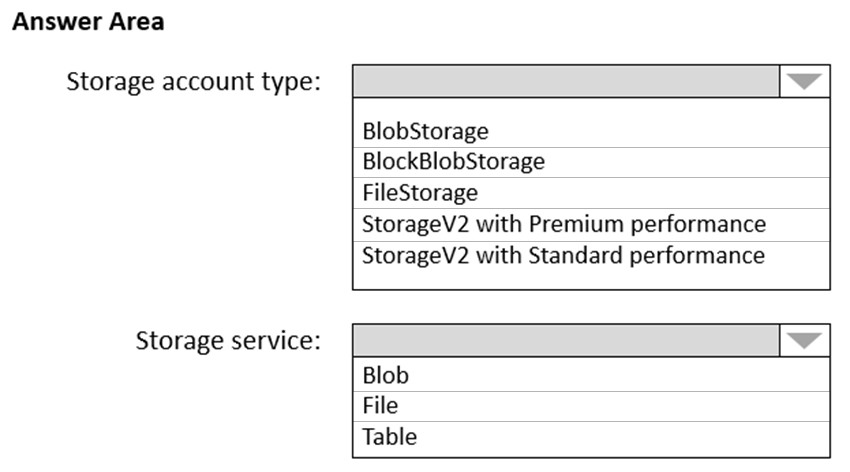
Answer:
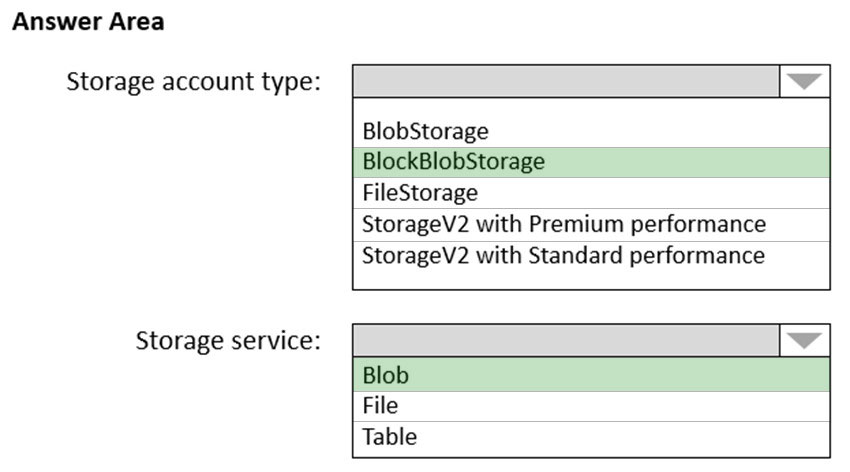
Box 1: BlockBlobStorage -
Block Blob is a premium storage account type for block blobs and append blobs. Recommended for scenarios with high transactions rates, or scenarios that use smaller objects or require consistently low storage latency.
Box 2: Blob -
The Archive tier is an offline tier for storing blob data that is rarely accessed. The Archive tier offers the lowest storage costs, but higher data retrieval costs and latency compared to the online tiers (Hot and Cool). Data must remain in the Archive tier for at least 180 days or be subject to an early deletion charge.
Reference:
https://docs.microsoft.com/en-us/azure/storage/blobs/archive-blob
HOTSPOT -
You have an Azure subscription that contains the storage accounts shown in the following table.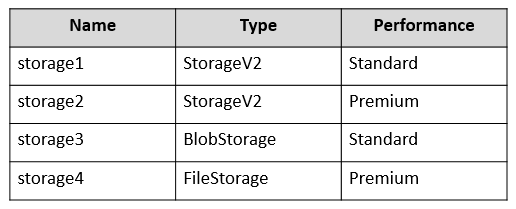
You plan to implement two new apps that have the requirements shown in the following table.
Which storage accounts should you recommend using for each app? To answer, select the appropriate options in the answer area.
NOTE: Each correct selection is worth one point.
Hot Area: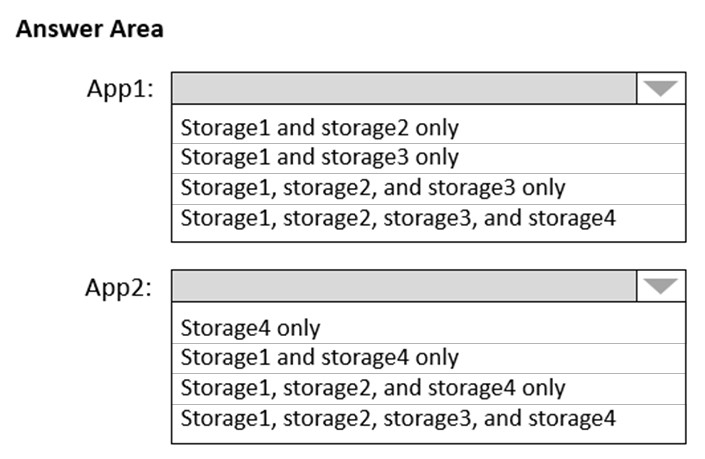
Answer:
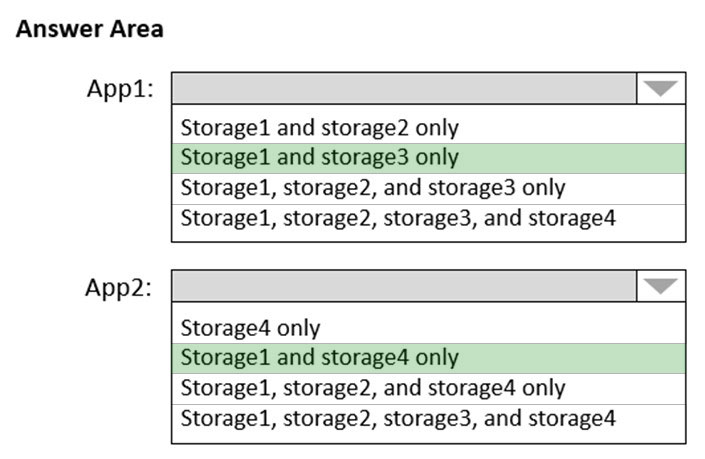
Box 1: Storage1 and storage3 only
Need to use Standard accounts.
Data stored in a premium block blob storage account cannot be tiered to hot, cool, or archive using Set Blob Tier or using Azure Blob Storage lifecycle management
Box 2: Storage1 and storage4 only
Azure File shares requires Premium accounts. Only Storage1 and storage4 are premium.
Reference:
https://docs.microsoft.com/en-us/azure/storage/blobs/access-tiers-overview#feature-support https://docs.microsoft.com/en-us/azure/storage/files/storage-how-to-create-file-share?tabs=azure-portal#basics
You are designing an application that will be hosted in Azure.
The application will host video files that range from 50 MB to 12 GB. The application will use certificate-based authentication and will be available to users on the internet.
You need to recommend a storage option for the video files. The solution must provide the fastest read performance and must minimize storage costs.
What should you recommend?
Answer:
C
Blob Storage: Stores large amounts of unstructured data, such as text or binary data, that can be accessed from anywhere in the world via HTTP or HTTPS. You can use Blob storage to expose data publicly to the world, or to store application data privately.
Max file in Blob Storage. 4.77 TB.
Reference:
https://docs.microsoft.com/en-us/azure/architecture/solution-ideas/articles/digital-media-video
You are designing a SQL database solution. The solution will include 20 databases that will be 20 GB each and have varying usage patterns.
You need to recommend a database platform to host the databases. The solution must meet the following requirements:
✑ The solution must meet a Service Level Agreement (SLA) of 99.99% uptime.
✑ The compute resources allocated to the databases must scale dynamically.
✑ The solution must have reserved capacity.
Compute charges must be minimized.
What should you include in the recommendation?
Answer:
A
The compute and storage redundancy is built in for business critical databases and elastic pools, with a SLA of 99.99%.
Reserved capacity provides you with the flexibility to temporarily move your hot databases in and out of elastic pools (within the same region and performance tier) as part of your normal operations without losing the reserved capacity benefit.
Reference:
https://azure.microsoft.com/en-us/blog/understanding-and-leveraging-azure-sql-database-sla/